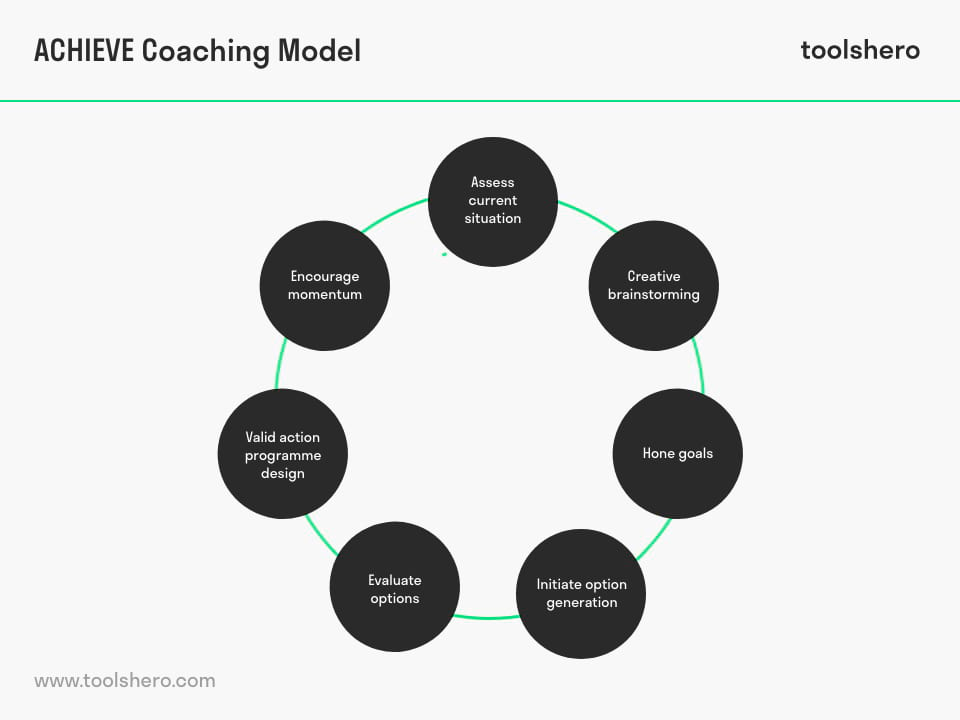ACHIEVE Coaching Model

ACHIEVE Coaching Model: in this article you will find a practical explanation of the ACHIEVE Coaching Model. After reading, you will understand this powerful method of goal setting and problem solving that offers 7 steps to achieve organizational goals. Enjoy reading!
What is the ACHIEVE Coaching Model?
The ACHIEVE Coaching Model is an extension of the GROW Coaching model that helps to achieve measurable and sustainable results for clients. It also supports feedback methods, increasing confidence with goal setting and problem solving effectiveness.
This coaching model raises and reviews the position of the company or project in which it is applied. One must know in which phase or moment the organization is in and what the leaders want to achieve in order to start developing the model.
The trainer or coach starts to ask questions such like: what is the current situation? What is working well? What challenges can be presented? How do the people involved feel? Among other questions.
By establishing what the moment is the organization is going through, the coach can establish a brainstorming to achieve the potential of new alternatives. With the brainstorming the coach can create new ideas with the team, giving voice and opinion on what they would like to see different and how this could be possible.
The brainstorming can be driven by other questions to make the development of change easier, such as What would you like to change? Why should it be changed? What alternatives for change are there? To complement this coaching model there are seven steps to developing coaching in a transparent and concrete way.

Figure 1 – the ACHIEVE Coaching Model
- Assess current situation
- Creative brainstorming
- Hone goals
- Initiate option generation
- Evaluate options
- Valid action programme design
- Encourage momentum
1. Assess the current situation
At this stage we should consider analysing the current situation we are experiencing. Reflect on and draw conclusions from the problems that exist and the goals that exist in order to improve future actions. Understand why you are where you are in order to move forward.
The coach can ask open questions and manage active listening in order to understand the situation and help the situation to move forward in a positive way.
Active listening in this phase is a way of accompanying the client or team members to receive information and observe possible solutions. Being curious and listening attentively to the client or the team.
2. Creative brainstorming
In this phase the coach stimulates with open questions and gets the participants to brainstorm on the exercise of progress and conflict resolution. Brainstorming is a method that can help to channel solutions to an impasse that is being experienced.
It is often believed that there are no possible alternatives to find a solution to a conflict. However, brainstorming sheds some light on the stressful situation, collecting different points of view, opinions and possible solutions to problems. Creativity is often the solution to what overwhelms a client or a team.
The coach helps to collect and guide these ideas for the solution that needs to be implemented in the situation and to achieve the objectives that are wanted.
3. Hone goals
At this stage, the objectives to be achieved are restructured or created. The coach starts to work with the group on the objectives and to formulate these objectives in the best possible way in order to achieve the desired success.
You can implement SMART (Specific, Measurable, Achievable, Realistic and Time-bound) and be clear about when you want to achieve your goals, how you want to achieve them and how you will measure them. The coaches will accompany their clients or their team in this process so that the goals are clear and precise in order to achieve success.
4. Initiate option generation
At this stage the different options for achieving the proposed goals can be collected. The coach can help with guiding questions such as: What options are there to achieve the objectives? How could you achieve those objectives? What professionals or team do you need to achieve them?
It should be kept in mind that at this stage only a collection of possible options is made in order to generate the fulfilment of the goals and objectives you want to achieve since the evaluation of these options will be made later when the best one is classified.
Active listening in this phase is also important, letting the team or the client speak will make them understand more specifically what they want to achieve from those potential options they have.
5. Evaluate options
In this phase the coach identifies the different options that will help you achieve your goals. He identifies and evaluates them and determines which option is the right one to put into action. The coach is the companion and guide in order to make the most appropriate decision and comply with the processes.
6. Valid action programme design
At this stage the options are put into practice, dividing them up in an organised way into an action plan with the help and guidance of the coach to achieve the goals.
At this stage the client or the team will follow the action plan through written and clear steps. The plan they will follow should provide time and performance indicators to meet the proposed goals.
7. Encourage momentum
In this last phase the motivation engine that the coach provides to his team is fundamental to achieve the agreed upon objectives. In work processes that may sometimes not be as fast as you think, staff may lose motivation and be distracted from achieving the objectives.
This is why it is important for the coach to continuously monitor how the processes are going. The coach will be aware of achieving the results you want to obtain, so motivation is an important key in this phase. The continuous relationship between the participants and the coach will make the fulfilment of the goals successful.
Key skills in the ACHIEVE Coaching Model
- Active listening
- Asking the right questions
- Timely follow-up
- Leadership
- Feedback
- Creativity
- Positive attitude to challenges
- To be able to motivate
The ACHIEVE Coaching Model is a systemic process. With the above steps and skills it will be possible to improve the fulfilment of the objectives that the client wants. The key is to be able to generate precise keys, to clarify the objectives and the strengthening of these objectives.
With this, people’s behaviour and processes will be able to have the desired success and also develop or improve the mentioned skills for the development of the work they need to do.
ACHIEVE Coaching Model: coaching as a personal and professional connector
This ACHIEVE Coaching Model is also used on a personal level to connect to professionals. This means that many professionals look for a coach when the company is going through changes and that these changes need guidance and help on an educational level to be able to accept and adjust the changes in the best possible way.
ACHIEVE Coaching also helps to improve the objectives and goals that the client has, this client can be a person, a team or a specific company that needs extra guidance and accompaniment.
It is important to know that this method of coaching can also be implemented by a leader who is within the company and not only by someone from outside as it is a method that any manager or leader can follow to give the company a systematic method in which they can find support step by step in the work or project they need.
People also tend to adapt this method in the personal sphere since a happy and motivated person can offer better performance in the company where they work. The accompaniment of a coach reminds and motivates people of the potential they have and how this is a fundamental part of an organisation.
ACHIEVE Coaching Model summary
The ACHIEVE Coaching Model is an addition to the GROW model. With ACHIEVE Coaching it is possible to improve and modify the objectives in an optimistic way with the follow-up and teamwork of the coach.
The model is used for moments of tension in which sometimes a company can find itself not knowing what steps to follow in order to solve problems and motivate team members to seek appropriate solutions.
This method makes you first question everything from the simplest to the most complex situation you are going through. Asking questions is one of the best ways to tackle a difficult situation, from the question that is sometimes thought to be less essential can open a path for the most creative ideas and set in motion the best processes to achieve success.
Apart from questions, it also invites deep reflection on individual work and teamwork. This is evident in this model, since motivation is essential to achieve the goals you want to have and thus plan the scheme in which the objectives will be met with the help of the coach.
Apart from the step-by-step approach of this model, the main actor must also be taken into account in order for the 7 steps to be successful. The main character is the coach, as he provides the necessary tools, guiding the client whenever he needs to, without putting all the responsibility on one person, as it is a start to finish job in the team and company.
The coach is the main engine to focus on what you want to achieve as it helps to rethink and evaluate the best options to achieve the success that the client wants. With your company or if someone wants to be the coach this method can help you as a guide to improve, organise and create new ways of developing business processes.
It’s your turn
What do you think? Have you used the ACHIEVE Coaching Model in your company? Are the seven steps important to be able to meet someone’s goals? Do you think ACHIEVE Coaching is a complement to the GROW model? If so, please let us know why. Is brainstorming always a good option when working under pressure? Do you have any suggestions or anything else to add?
Share your experience and knowledge in the comments box below.
More information
- Dembkowski, S., & Eldridge, F. (2003). Beyond GROW: A new coaching model. The international journal of mentoring and coaching, 1(1), 21.
- Carey, W., Philippon, D. J., & Cummings, G. G. (2011). Coaching models for leadership development: An integrative review. Journal of leadership studies, 5(1), 51-69.
- Garmston, R. J. (1987). How administrators support peer coaching. Educational leadership, 44(5), 18-26.
- Lennard, D. (2013). Coaching Models: A Cultural Perspective: A Guide to Model Development: for Practitioners and Students of Coaching. Routledge.
How to cite this article:
Ospina Avendano, D. (2021). ACHIEVE Coaching Model. Retrieved [insert date] from Toolshero: https://www.toolshero.com/management/achieve-coaching-model/
Original publication date: 01/07/2021 | Last update: 09/01/2023
Add a link to this page on your website:
<a href=”https://www.toolshero.com/management/achieve-coaching-model/”>Toolshero: ACHIEVE Coaching Model</a>












